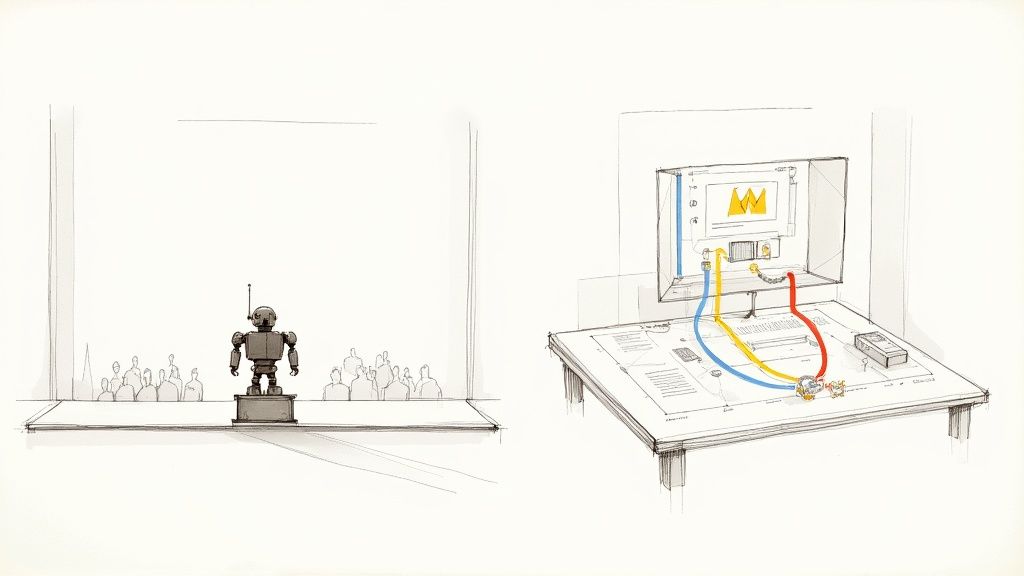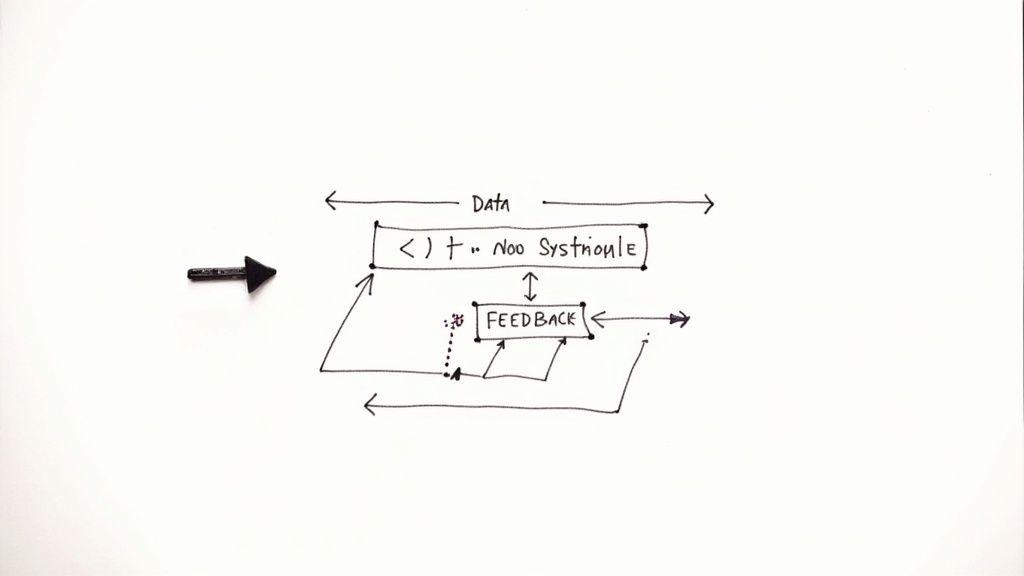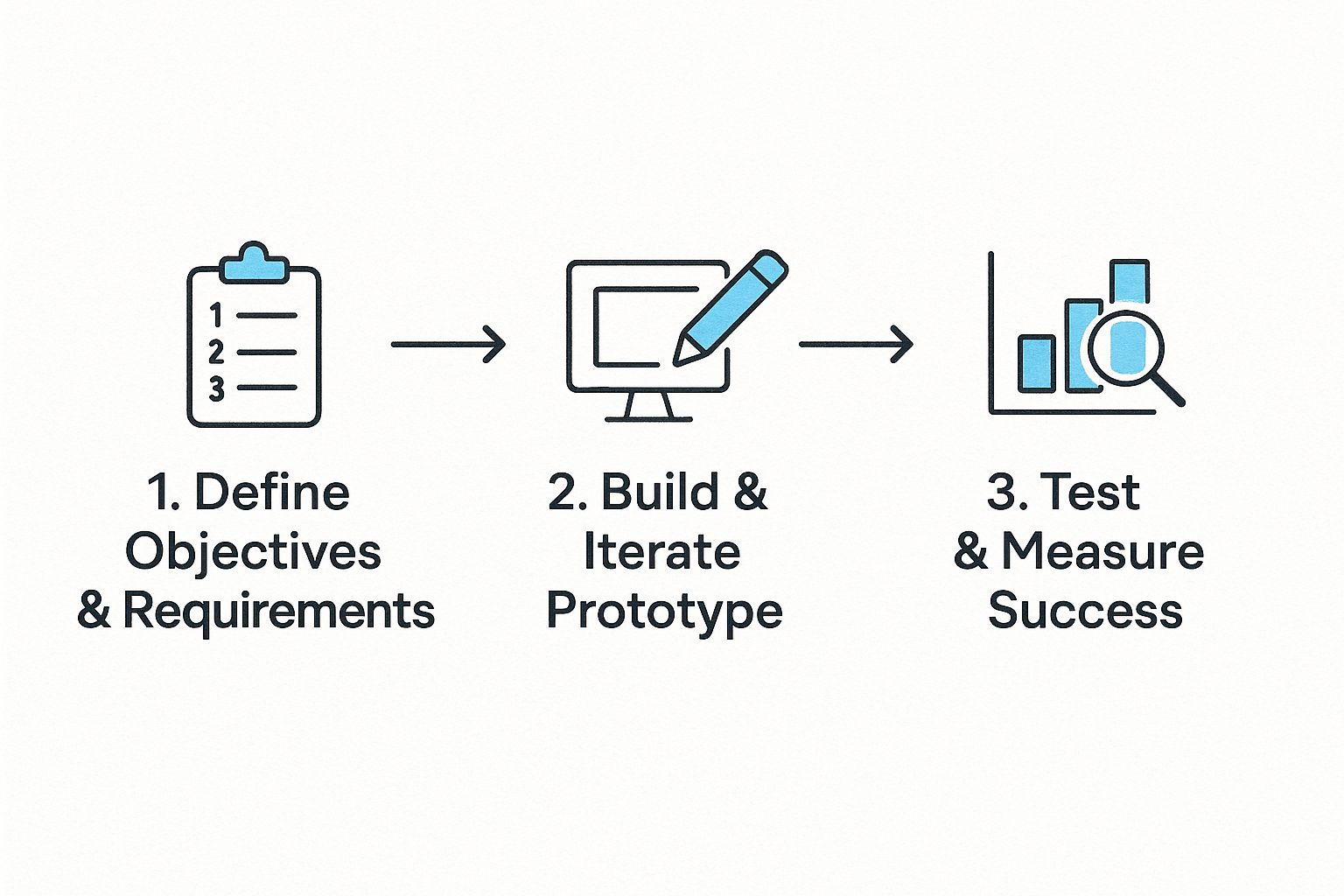Why AI Startups Don’t Do Demos Anymore, They Prove It First with a PoC
AI startups don’t do demos anymore; they prove it first with a proof-of-concept to showcase real value and build trust quickly. Learn how!

In the world of AI, the flashy product demo is losing its shine. We’re seeing a major shift in how smart investors and potential clients evaluate new technology. The old saying "show, don't tell" has a new spin: AI startups don’t do demos anymore, they prove it first with a proof-of-concept (PoC). It’s a change born from a simple reality—promises are easy, but real, verifiable results are what build trust and create genuine value.
The End of the Theatrical AI Demo

For a long time, the startup playbook was straightforward: build a polished, highly controlled demo. This presentation was an art form, carefully staged to show off a product’s potential in a perfect world, using hand-picked data to make every feature look flawless. The problem is, in the messy, complicated world of artificial intelligence, this kind of performance often hides more than it actually reveals.
A slick demo can easily paper over an AI model's fundamental weaknesses, especially its ability to cope with the chaotic, unpredictable data that real businesses run on. Stakeholders have become rightly sceptical of impressive presentations that crumble when faced with a real-world test. All the hype has created a credibility gap, and the PoC has become the essential bridge to get across it.
From Promises to Practical Validation
Switching to a proof-of-concept isn't just a passing trend; it's a vital strategy for any AI company that wants to survive and grow in a crowded market. A PoC fundamentally changes the conversation. It shifts from, "What could your AI theoretically do?" to "What can your AI do for us, with our data, right now?"
This is especially critical in mature, cautious markets. Take Germany's thriving AI scene, for example. It’s home to 508 AI startups and a market that recently swelled by a third to €6.3 billion. This growth is built on a bedrock of industrial pragmatism. While government initiatives encourage AI adoption, German clients demand reliability over spectacle. For any startup wanting to succeed there, a solid PoC isn't just a good idea—it's essential. You can find more on Germany's AI landscape at deutschland.de.
A Proof-of-Concept is a powerful de-risking tool. It forces a startup to confront real-world challenges early, building a partnership based on demonstrated capability rather than aspirational claims.
Key Differences at a Glance
To really get why this change matters, you need to see the core differences between the old way and the new. A demo is basically a monologue; a PoC is a dialogue. One sells a vision, the other validates an actual solution.
To make this crystal clear, here’s a quick table breaking down the two approaches.
Demo vs Proof of Concept Quick Comparison
Attribute | Traditional Demo | Proof of Concept (PoC) |
|---|---|---|
Objective | To impress and generate excitement | To validate a specific hypothesis and prove technical feasibility |
Data | Uses clean, pre-selected "canned" data | Uses a sample of the client's actual, often messy, operational data |
Environment | Runs in a controlled, optimised setting | Operates within a sandboxed version of the client's real-world environment |
Outcome | To secure the next meeting | To secure a clear "yes" or "no" on a specific business case, paving the way for a full-scale project |
This evolution is a clear signal of an industry coming of age. As AI gets woven deeper into the fabric of business operations, the need for verified, dependable, and secure solutions will only intensify. Startups that embrace this PoC-first mindset are building their future on a foundation of tangible results, not just promises.
Understanding the PoC Advantage
If you've ever watched a movie trailer, you've seen a traditional product demo. It’s a highlight reel, showing only the most polished, exciting scenes. A Proof-of-Concept (PoC), on the other hand, is more like a pilot episode. It has to prove the core concept is compelling enough to carry a full season.
That’s why in the world of artificial intelligence, a major shift has occurred: AI startups don’t do demos anymore, they prove it first with a proof-of-concept. This isn't just a different sales tactic; it’s a calculated, evidence-based approach that lowers the risk for everyone involved, from the client to the investors watching on the sidelines.
Validating Technical Feasibility with Real Data
The biggest edge a PoC has over a demo is its reliance on real, client-specific data. A standard demo runs on pristine, hand-picked datasets—the kind designed to make the AI look flawless. A PoC dives straight into the messy, unpredictable, and often incomplete data that businesses grapple with every single day.
When an AI model can successfully chew through a sample of a client's actual operational data, it answers the one question that truly matters: "Will this work for us?" It’s a level of validation that no slick presentation can ever match. You’re swapping assumptions for hard evidence.
This practical test builds a foundation of trust that a generalised demo simply can't. It shows the startup isn't afraid to get its hands dirty and that its technology can handle the unique chaos of a client's real-world environment. That initial success speaks volumes about future performance.
Demonstrating Genuine ROI Potential
At its core, a PoC is built to solve a small but meaningful business problem. In doing so, it offers a tangible glimpse into the potential return on investment (ROI) of a full-blown project. It’s one thing to hear a sales pitch about boosting efficiency; it's something else entirely to watch an AI model accurately categorise 10,000 customer support tickets in a fraction of the time it would take your team.
Suddenly, the conversation shifts from abstract benefits to measurable results. The key outcomes a PoC can highlight include:
Cost Reduction: Proving exactly how automation can cut down on manual labour or operational overhead.
Revenue Growth: Showing how AI-driven insights can pinpoint new sales opportunities or improve customer retention.
Efficiency Gains: Quantifying the hours saved on specific, repetitive tasks.
A successful Proof-of-Concept is the most compelling sales tool an AI startup has. It transforms a potential solution from a cost centre into a strategic investment by proving its value proposition with the client’s own data.
Building a Collaborative Partnership
Unlike a demo, which is usually a one-way presentation, a PoC is collaborative by nature. The startup and the client have to roll up their sleeves together to define the scope, agree on what success looks like, and get the necessary data into the system. This shared effort lays the groundwork for a strong, long-term partnership.
From the very beginning, this process ensures both sides are aligned and genuinely invested in the outcome. It turns what could have been a simple transactional sale into a joint venture from day one. In fact, developing a solid PoC is a cornerstone of any effective AI adoption plan, a topic we cover in our guide to building a successful AI strategy.
Why Investors Now Demand Proof Over Promises

From a venture capital perspective, the rules of the game have completely changed. Gone are the days when an ambitious roadmap and a slick presentation were enough to secure funding for an AI startup. Investors, especially in competitive European hubs, have grown wary. They’ve seen far too many promising demos fall flat when faced with real-world complexities.
This shift comes down to one thing: a demand for tangible evidence. When an investor performs their due diligence today, they are laser-focused on a single, critical question: can this team actually deliver? Answering that means going way beyond the pitch deck. This is exactly why AI startups don’t do demos anymore; they prove it first with a proof-of-concept. It’s all about concrete validation.
A PoC acts as the ultimate litmus test. It shows that the technology works, which is great, but more importantly, it proves the founding team has the chops to turn an idea into a functional tool that creates real value for a business.
The Rigours of European Due Diligence
This demand for hard evidence is particularly intense in European financial centres, where thorough due diligence is the norm. The venture capital scene in Germany, for example, puts this trend in sharp focus. While European AI funding still has ground to make up on the US, Germany, alongside the UK and France, forms the continent's core. In 2023-2024, these three countries snapped up 77% of all AI funding in Europe.
With over 500 German AI startups in the ring, you have to bring more than just a good idea to the table to secure a piece of that pie. You need verified proof. It's this intensely results-driven environment that makes a solid PoC non-negotiable. You can find more detail on these trends in this report on European AI funding from Innovation Zurich.
For an investor, a PoC lays out a clear, evidence-based roadmap to making money. It sends a powerful signal that the startup not only understands its market but can actually follow through on its promises.
A Proof-of-Concept transforms a funding pitch from a conversation about "what if" to a demonstration of "what is." It provides investors with the tangible, verifiable results they need to justify a high-stakes investment.
This approach fits perfectly with the cautious but meticulous nature of European corporate and financial culture. In this environment, a successful PoC is the most valuable currency a startup can have. It’s not just about showing off cool tech; it’s about proving you have the business sense to handle real-world challenges.
So, for any AI startup looking for serious funding, the message couldn't be clearer: show, don’t just tell. Prove your worth with a PoC, and you'll earn your seat at the table.
How to Structure a Winning AI Proof of Concept
Building a successful Proof of Concept (PoC) isn't about following a rigid template; it's a structured journey you take with your potential client. Forget the polished, one-size-fits-all demo. The real power of a PoC lies in tackling a genuine business problem with a transparent partnership from the very beginning. This is how you transform a technical exercise into a compelling validation of your technology.
The whole process kicks off with a simple, but absolutely critical, conversation. Before a single line of code is written or any data gets analysed, the startup and the client need to sit down together and agree on what "success" actually looks like. This isn't just a box-ticking exercise; it’s the bedrock of the entire project.
This first phase is all about translating a big, vague business pain point into a focused, solvable challenge. For instance, if a client says they want to “improve customer service,” a smart PoC narrows that down to something concrete, like “reduce initial response times for high-priority support tickets by 20% using our AI model.”
Defining the Scope and Success Metrics
Where do most PoCs go wrong? Scope creep. It’s that all-too-common scenario where a focused objective slowly expands until it becomes an unwieldy, unmanageable beast. The best way to prevent this is by creating a crystal-clear Statement of Work (SOW) that serves as the project's North Star.
This document should leave no room for ambiguity and clearly outline:
The Core Hypothesis: What specific business value are we trying to prove?
Success Metrics: How will we measure the outcome? These need to be numbers you can point to, like "achieve 90% accuracy in categorising supplier invoices."
Data Requirements: What exact data do you need from the client, and in what format?
Timeline and Milestones: Set realistic deadlines for every stage, from preparing the data to the final analysis.
A well-defined PoC fundamentally changes the conversation. It shifts from a vague "Does your AI work?" to a much more powerful "How well does your AI solve this specific problem for us?" It’s a subtle but profound change that paves the way for a real, evidence-based evaluation.
With a solid framework locked in, it's time to move into the building and testing phases. This is where the rubber meets the road and where savvy AI startups really show their mettle by delivering on their promises.
To guide this process, it's helpful to break down the PoC into distinct stages. Each phase has a clear goal and common traps to sidestep.
Here’s a table outlining the key stages of an effective AI PoC:
Key Stages of an Effective AI PoC
Stage | Key Objective | Common Pitfall to Avoid |
|---|---|---|
1. Discovery & Alignment | Co-define a specific, measurable business problem and success criteria with the client. | Starting to build without clear, agreed-upon metrics. |
2. Data Preparation | Secure and clean the necessary client data to train and test the model. | Underestimating the time and effort required for data wrangling. |
3. Model Development | Build a focused prototype that directly addresses the core hypothesis. | Over-engineering the solution; it only needs to prove the concept. |
4. Controlled Testing | Run the model in a sandboxed environment using the prepared data. | Lacking a controlled environment, leading to inconclusive results. |
5. Analysis & Reporting | Measure performance against the initial metrics and present a data-driven report. | Presenting a sales pitch instead of an objective analysis of the findings. |
This structured approach ensures that both sides remain aligned and focused on the ultimate goal: proving tangible value.
The following infographic visualises this flow, showing how a PoC is much more than just the build phase.

As you can see, building the prototype is just one piece of a much larger strategic puzzle, held together by rigorous planning at the start and objective analysis at the end.
Executing the PoC and Analysing Results
Once the prototype is ready, it’s deployed in a controlled, "sandbox" environment using the client's own data. This part of the process is all about iteration. The model gets tested, its performance is measured against the metrics you both agreed on, and adjustments are made along the way. Transparency is everything here; regular check-ins keep the client in the loop and invested in the outcome.
The final step is presenting the results. This isn't another sales pitch. It’s a straightforward, data-driven report that speaks directly to the initial hypothesis. Whether the PoC was a massive success or uncovered some unexpected challenges, the outcome always delivers invaluable insight. This is exactly how AI startups don’t do demos anymore, they prove it first with a proof-of-concept, turning a simple trial into a trusted partnership.
For anyone looking to get hands-on experience in structuring these crucial engagements, joining a dedicated AI discovery workshop can provide the practical guidance needed to truly master this process.
Right, let’s talk about the tricky side of proofs-of-concept.
Navigating the Challenges of a PoC
While jumping straight to a PoC is a smart move, it’s not without its risks. Let’s be honest: if you’re not careful, you can end up pouring a huge amount of time and resources into a project that never turns into a paying contract. This is why the new mantra is AI startups don’t do demos anymore, they prove it first with a proof-of-concept—but they have to go in with their eyes wide open.
Choosing this path means you have to anticipate the roadblocks. Getting from that first promising chat to a successful PoC is often a minefield of data access issues, security headaches, and the ever-present threat of scope creep. Knowing how to handle these challenges is what separates the startups that succeed from those that get taken for a ride.
The Dangers of Scope Creep and Unpaid Labour
The biggest trap in any PoC is easily scope creep. It’s that slow, insidious expansion of the project’s goals beyond what you originally agreed to. You start with a laser-focused plan to test one specific thing, and before you know it, you’re knee-deep in an unpaid consulting gig. This doesn’t just burn out your team; it makes it almost impossible to ever hit a clear finish line and declare victory.
A rock-solid Statement of Work (SOW) is your primary defence here. But even with a great SOW, the pressure to over-deliver and impress a potential big-name client is immense. You can quickly find yourself putting in a massive amount of unpaid work, which is a dangerous game for any early-stage company trying to keep the lights on.
A PoC should be a focused validation, not a free-for-all development cycle. The goal is to prove one thing exceptionally well, not to solve every problem the client has. Setting firm boundaries from the start is essential for survival.
Mitigating Risk with Smart PoC Structures
You have to be strategic about how you structure these engagements to protect your company. Handing out free PoCs to every company that shows a flicker of interest simply isn’t a viable business model. Instead, here are a few battle-tested strategies to reduce your risk and make sure you’re valued for your work:
Structure Paid PoCs: The most straightforward way to get a client to take this seriously is to charge for it. Even a small fee changes the dynamic completely. It confirms the client has a real budget and a real problem, and it frames the PoC as the valuable service it is, not just a freebie.
Create an Ironclad SOW: Your Statement of Work needs to be crystal clear on the essentials. Lock down the exact problem you’re solving, the precise metrics that define success, the data you need from them, and a non-negotiable timeline. Think of this document as your shield.
Establish Robust Data Governance: Data is the fuel for any AI PoC, but it’s also where things get bogged down. You need to tackle data access, privacy, and security right from the get-go. A clear data governance plan not only smooths the process but also shows the client you’re a professional outfit that can be trusted with their sensitive information—a huge sticking point for many large organisations.
The Future Is Proven AI, Not Promised AI
We're witnessing a fundamental shift in how AI solutions are bought and sold. This isn't just some passing fad; it signals that the entire industry is growing up. The days of flashy, smoke-and-mirrors demos are over, replaced by a much more grounded, evidence-based approach. The new rule is simple: AI startups don’t do demos anymore, they prove it first with a proof-of-concept. This isn't merely a change in sales strategy—it's an essential evolution for building real, sustainable businesses on a foundation of tangible results.
As artificial intelligence weaves itself deeper into the fabric of core business operations, the demand for verified, reliable, and secure solutions will only intensify. A slick promise on a PowerPoint slide just doesn't cut it anymore. Today's stakeholders, quite rightly, demand to see the technology work within their own complex systems, with their own messy data, before they commit to a serious investment. The PoC is the bridge that builds that crucial trust and takes the risk out of adoption.
Credibility in the AI space is earned through execution, not ambition. The proof-of-concept is where that execution begins, transforming a promising idea into a validated business asset. It’s the difference between a captivating story and a verifiable success.
The AI startups that thrive tomorrow will be the ones that master the art of proving their value from the get-go. They'll understand that a successful PoC is the most powerful sales tool in their arsenal, capable of turning healthy scepticism into genuine confidence and potential into measurable ROI. It’s an approach that cuts through the hype and channels resources into solutions that actually solve real-world business problems.
When you build a company on a bedrock of proven results, you forge stronger client partnerships from day one. It shows a commitment to transparency and a genuine desire to understand what your customers truly need. For any AI startup with its eyes on long-term success, the message couldn't be clearer: the future isn't about promised AI, it's about proven AI.
Frequently Asked Questions
It's natural to have questions when shifting from flashy presentations to projects that deliver tangible results. As more businesses realise that AI startups don’t do demos anymore, they prove it first with a proof-of-concept, getting a handle on the details is key to making smart decisions. Let’s tackle some of the most common queries we hear.
What Is the Main Difference Between a Demo and a PoC?
Here’s a simple way to think about it. A demo is like a perfectly staged cooking show. Everything is prepped, the ingredients are flawless, and the final dish looks incredible under the studio lights. It’s designed to show you what the AI could do under ideal conditions. It’s a sales pitch.
A PoC, on the other hand, is like inviting that same chef into your own kitchen. They use your ingredients—the ones you actually have—and try to cook one specific dish from your menu. The goal isn't just to impress, but to prove the recipe works with your real, and often messy, setup. It’s a genuine test of feasibility and business value in your specific environment.
Are Proof-of-Concepts Always Free?
No, and frankly, a free PoC can be a red flag. While some startups might dangle a free PoC as a tempting offer, a paid engagement is almost always a better indicator of a serious partnership.
When a client pays for a PoC, it shows they're genuinely invested and have a budget allocated to solve the problem. For the startup, it ensures they're compensated for their expert time and the resources they dedicate. This mutual commitment frames the project as a professional service, not a favour, and establishes a foundation of respect right from the start.
A paid PoC is a powerful filter. It confirms that the client has a genuine, funded problem to solve and isn't just "tyre-kicking" or seeking free consulting. This mutual investment is the foundation of a true partnership.
How Long Should an AI PoC Take?
A well-structured AI PoC should typically land somewhere between four to eight weeks. This timeframe is the sweet spot—it’s long enough to properly handle data preparation, model building, and analysis, but short enough to prevent the project from losing momentum.
Keeping the timeline tight forces everyone to stay laser-focused on the agreed-upon goals. If a PoC starts stretching beyond a couple of months, it’s often a warning sign that the scope has become bloated or the initial objectives weren't clear enough.
For a deeper dive into other common questions, feel free to explore our comprehensive FAQ page for more insights.
At Ekipa AI, we believe in moving past hypotheticals and into proven results. Our platform is designed to help you pinpoint and structure high-impact AI proof-of-concepts, transforming promising ideas into validated, scalable solutions. Discover your AI opportunities at https://www.ekipa.ai.



